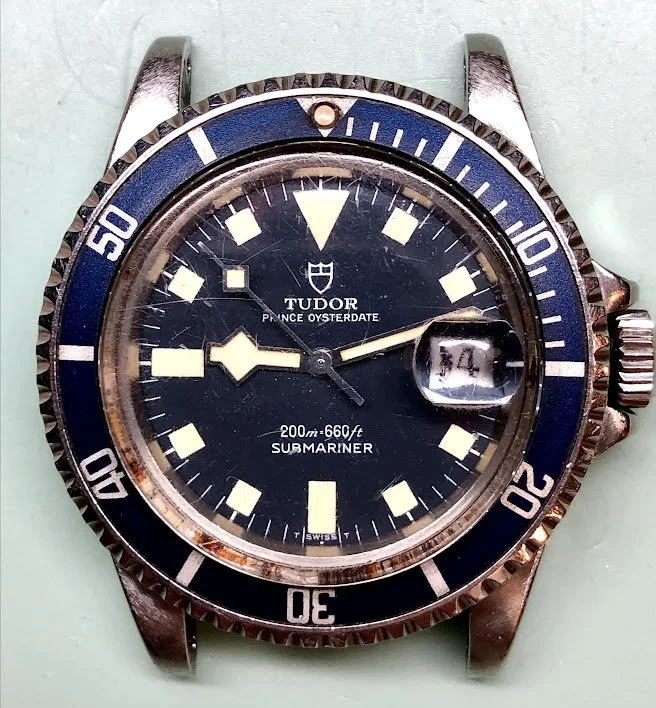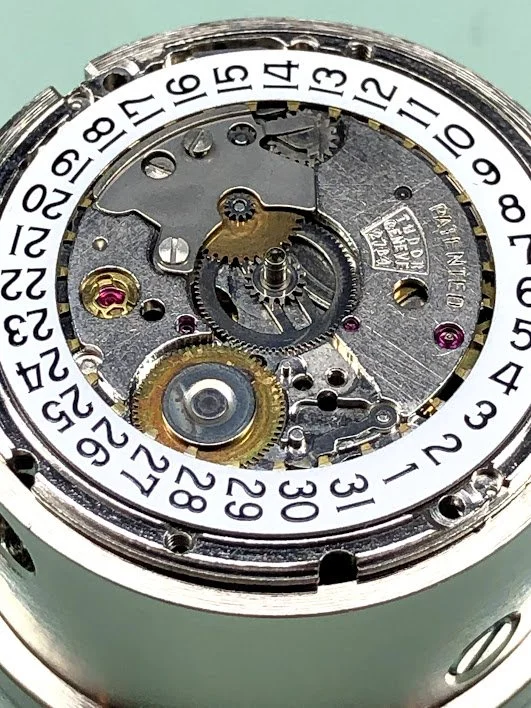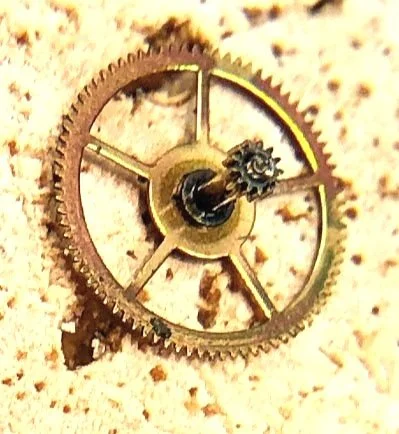Restoring a vintage Tudor Submariner
A deep dive into a vintage overhaul.
There are many types of vintage watch owner. The uninitiated curious owner who either just inherited or found a watch, and is looking for answers (hopeful that they’ve found treasure). The pragmatic collector who chooses aesthetics over functionality and reliability. The collector who believes watches are an investment vehicle, keeping their precious collection safe and untouched, and holding originality in the highest possible regard. Almost all of them will ask for their original parts back at the end of a service. Some watchmakers will complain about this, but the truth is that we rarely ever throw anything away anyways.
Vintage Tudor Submariner during case disassembly.
Today we will discuss a service for my favorite kind of customer: a lifelong owner who wears the watch every day, indifferent to current market value. This individual brought me a Tudor Submariner, a ref. 9411/0 I believe, that they had purchased when it was brand new. It wasn’t running when it reached my bench. The bracelet was original, with folded links, and it was tired of being bent and riveted back into submission. When I offered to return the original bracelet, they replied “and do what with it?”. The watch had clearly had a few services in its long life, but it was time for a major overhaul inside and out. My first stop when I see a watch like this with a pragmatic owner is to try the manufacturer to see if they service this model in their restoration department. In this case Tudor would not, so it was up to me to take care of the customer. Luckily I was in a position to obtain genuine parts, and in possession of a service guide listing those parts. Unlike most vintage overhauls, I could guarantee water resistance, which would enable the owner to continue to wear the watch on a daily basis here in the rainy Pacific Northwest.
Caseback removed, prior to cleaning.
It’s fairly common for customers to request movement service only, and in the case of this watch it seems like the previous watchmakers obliged. The gaskets were dried and cracked, and you can see the amount of debris and rust that had worked its way into the case apertures.
It’s my policy to disassemble the entire case, and perform a full water resistance renewal as much as possible. It’s difficult to offer a warranty on work when I haven’t even looked over and cleaned the case. There’s a lot of responsibility in being the last person to have touched a watch — especially when it’s potentially near the end of its functional life.
It’s essential to remove any debris and rust from the case prior to uncasing the movement.
First I remove the dirt and debris with a dry brush, cotton swabs, and tiny puffs of air from my hand blower. Then it’s time to separate the job into two parts- the movement/dial/hands, and the case/bezel/bracelet. While the stakes are high in vintage work, the stakes are highest when it comes to handling a dial and hands (especially on a piece with such distinctive features). Arrant debris can easily scratch a dial, and the luminous paint is often brittle and can chip if any pressure is applied.
This watch has a matte dial, which is highly susceptible to smudging and is easily burnished. The lume on the hands had been previously reinforced, and the owner of the watch didn’t want them redone. No argument from me there. Flooding those fully luminous hands would be very tricky, and there was no issue with the previous work interfering with hand clearance.
Some wear along the edge of the dial. It’s very common, and caused by impact.
In vintage sport watches, wear along the edge of the dial is common. In glossy dials this can lead to the surface finish peeling, often taking the minute track printing along with it. If this goes too far, the dial will eventually need to be replaced or reprinted. Flaking bits of lacquer, no matter how seemingly insignificant, will get in to the movement and cause problems. If at all possible, I recommend uncasing the watch during the estimation process to assess the condition of the edge of the dial.
The backside of a dial usually looks like this. Rough.
Once the dial and hands are off, it’s important to assess the condition of the dial feet. First of all they should still be attached and straight, and second they should be free of cracks or old solder repairs. Damaged dial feet require an uncomfortable conversation with the client. Repair usually requires heat or electricity, which means a high likelihood for destruction. Luckily in this case everything there’s nothing to worry about.
Dial side of the ETA 2784
Next we assess the movement condition. Since it’s not running we start from square one. This movement contained lots of dirt and grime, so I started by removing the date wheel and getting the complete movement in for a cycle through my watch cleaner. But even that wasn’t enough to remove the stubborn gunk in this watch.
Dirty bridges and gunky wheels.
Note some dirt on the wheel, as well as green film.
After a pre-cleaning, the movement is disassembled and cleaned by hand. Usually I will run the wheels across a piece of pith wood before final cleaning, and that would be enough. In my experience with clocks, which are exposed to lots of dust, the teeth of the wheels are routinely flossed during an overhaul. It’s really unusual to have to floss the teeth of a watch of this age, but in this case special attention was required and given.
Check back for Part 2, where we complete disassembly, and discover the source of the gunk!









